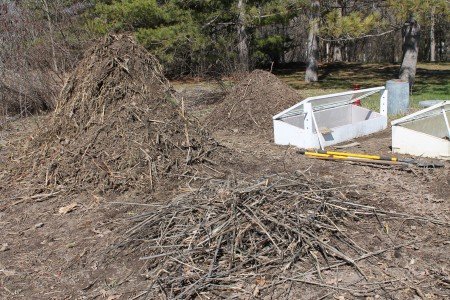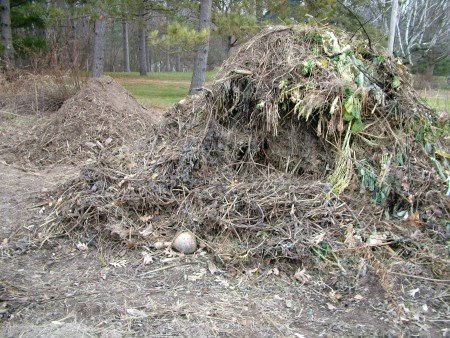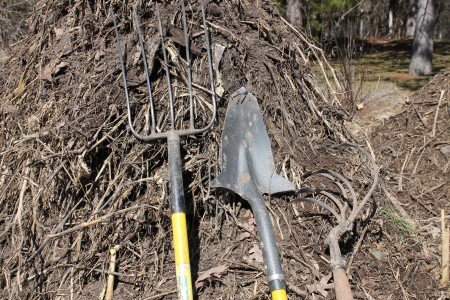Compost solves everything! Well, not quite, but one can garden in compost alone and you cannot have too much. This year I’m way ahead. I’ve got a pile of ready to apply material (the smaller pile in the picture). And even though it’s still too wet in the garden beds to do much work, I took advantage of two unexpected warm and dry days to turn the pile I had created throughout last year.
This is what I started with. The picture was taken in December. The pile is all the plant residue left from the harvests, all the weeds I harvested, plus the contents of a 55 gallon drum of household compost we collect. I talk about using the barrels to save household compost here and here.
I took last year’s pile and moved it over about 10 feet. Turning the pile will speed up the decomposition and accelerate the cooking process that breaks down plant material into compost.
Turning the pile could be very difficult and time consuming. The layers of spent plants, twigs, stalks and stems form a matted layer that is woven together and very hard to separate. Trying to scoop it off and separate it with a fork or shovel approaches futility.
That’s where the old five-tine cultivator again shows itself to be a multi-dimensional tool that should still be made. I used that tool to rip apart the matted mess. Then forking the compost to the new pile becomes quite easy. The third tool I use is a shovel with a novel design that I was introduced to two years ago at the Philadelphia Flower Show. It’s sold under the trade name Spear Head Spade. Its small sharp and strong head makes it ideal for slicing through hard soil and plant material. It’s very easy to use to cut compacted soil and cut into and through plant material. So with these three tools, a manure fork, an old fine-tined cultivator, and a Spear Head spade, I turned over this very large pile of compost in just a few hours.
I also used the old five-tined tool to loosen and level the soil where last year’s pile resided. I laid down some stalks from the semi-wild patch of Jerusalem artichokes I have growing in the area. That’s where I’ll build this year’s compost pile to keep the process going. Compost is extremely easy to make. It’s a naturally occurring process and good gardeners covet it. I’m lucky I have a large area and ample inputs to have almost all the compost I could want.




Great information. I do some composting, but nothing that approaches the scale of your project.
I got one of those old 5 tine cultivators, I think I bought it after I met you at the Valparaiso Indiana Garden show. I just need to find the darned thing now. We us compost bins, and a compost twin, but do some pile composting as well, our piles aren’t as big as yours that is for sure!